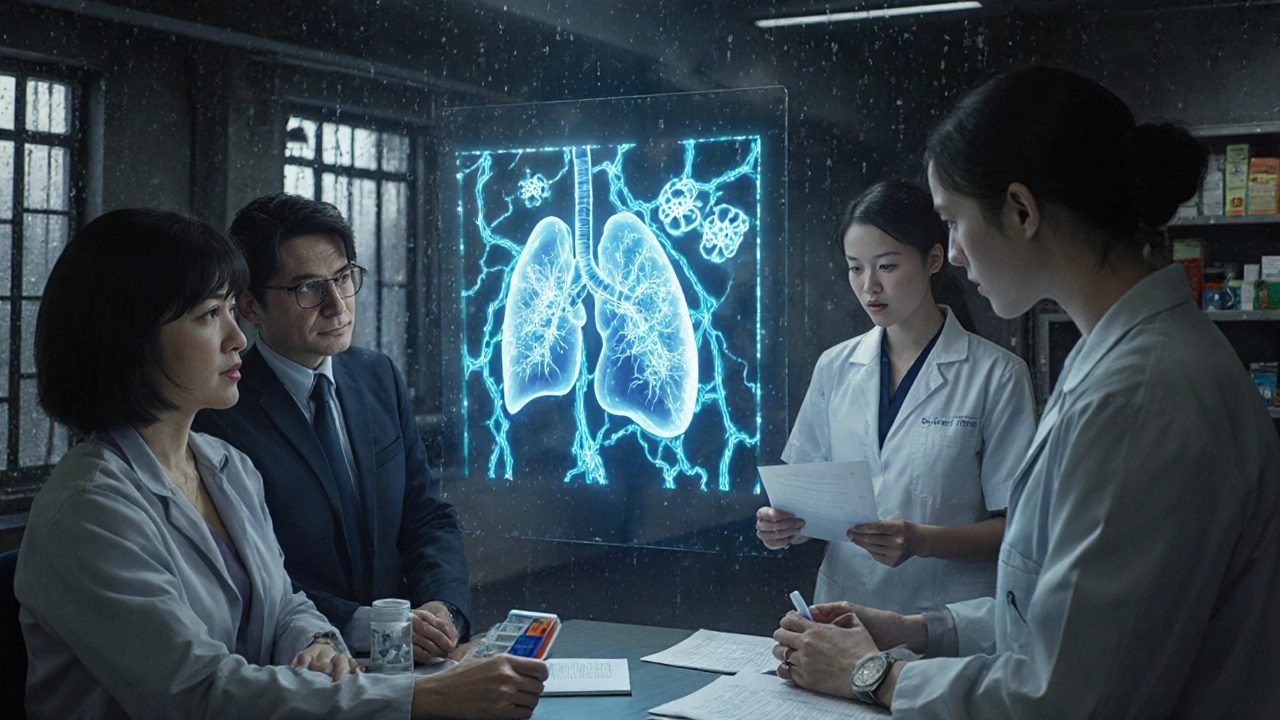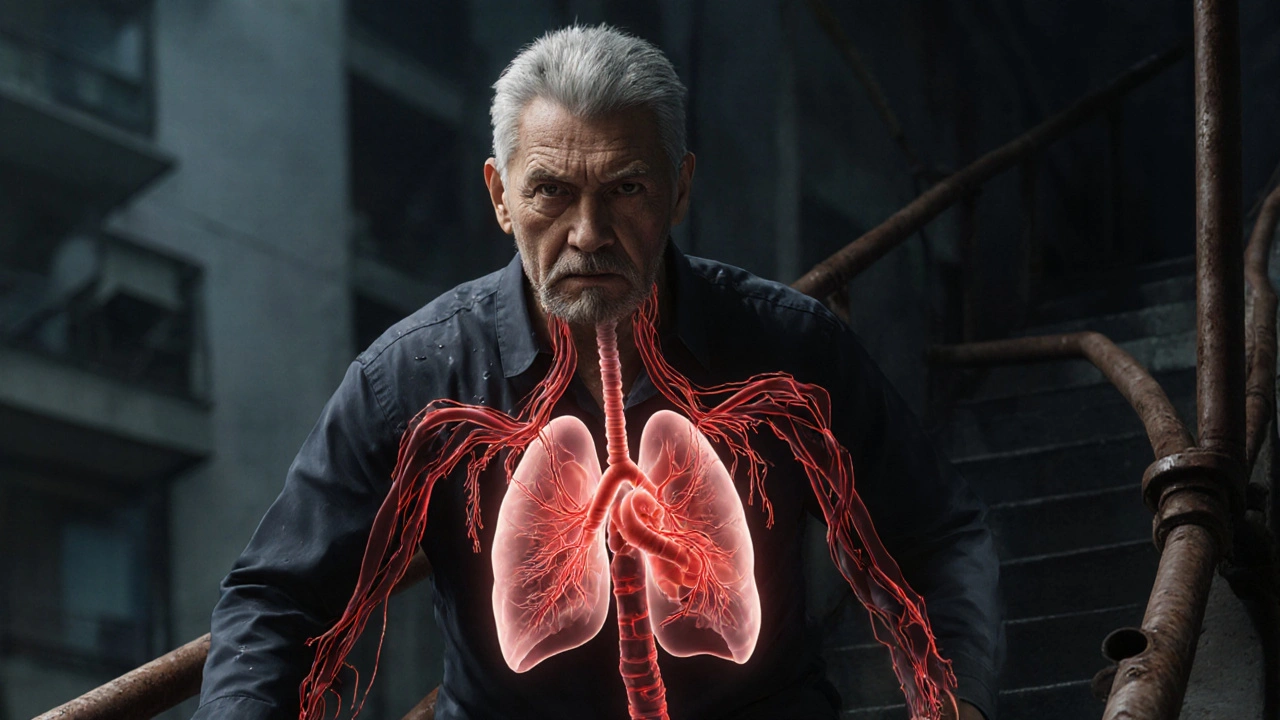Pulmonary hypertension isn't just high blood pressure in the lungs-it's a silent killer that slowly weakens the right side of your heart. Many people mistake its early signs for asthma, aging, or being out of shape. By the time they get a proper diagnosis, the right ventricle is already struggling to pump blood through narrowed lung arteries. Without treatment, this strain leads to heart failure. But today’s therapies can change that trajectory-if caught early.
What Pulmonary Hypertension Really Feels Like
Most patients don’t wake up one day with chest pain or a cough. Instead, they notice something small but persistent: breathing harder than usual during routine tasks. Climbing stairs, walking to the mailbox, or even folding laundry becomes exhausting. This isn’t just being tired-it’s progressive dyspnea, the hallmark symptom of pulmonary hypertension (PH).
Other early signs include swelling in the ankles or legs (edema), a racing heartbeat (palpitations), and fainting spells during activity. These aren’t random. They’re clues your body is sending because the right ventricle is working overtime to push blood through stiff, constricted pulmonary arteries. The pressure in those arteries rises above 20 mmHg at rest, a threshold lowered in 2022 from the old 25 mmHg standard. That change means more cases are now being caught earlier.
One Reddit user, u/PHWarrior1987, shared how his doctor dismissed his symptoms for 18 months: “He said I was just out of shape.” By the time he got a right heart catheterization, his 6-minute walk distance had dropped to 220 meters. That’s far below the 380-meter mark linked to poor survival. He wasn’t lazy-he was sick.
How Right Heart Strain Shows Up on Tests
Pulmonary hypertension doesn’t just cause symptoms-it changes the structure and function of your heart. The right ventricle, which normally pumps blood gently into the lungs, starts thickening and stretching under pressure. Doctors look for three key signs of this strain:
- Right ventricular hypertrophy: Wall thickness greater than 5 mm on echocardiogram
- Right ventricular dilation: End-diastolic area larger than 22 cm²
- Reduced TAPSE: Tricuspid annular plane systolic excursion under 17 mm, showing the heart’s pumping ability is failing
These aren’t just numbers. They’re survival predictors. A TAPSE under 17 mm means your heart can’t generate enough force. A BNP level over 180 pg/mL or NT-proBNP over 1,400 pg/mL signals severe strain and higher death risk. In one case from the PHA registry, a patient’s BNP dropped from 850 to 190 in just three months after switching to triple therapy-proof that treatment works.
Cardiac MRI gives the clearest picture of right heart function, showing exact volumes and muscle mass. But it’s not widely available. Only 37% of PH centers have it. Most rely on echocardiograms, which are easier to get but less accurate. Studies show echo overestimates pulmonary pressure by 10-15 mmHg in over half the cases. That’s why doctors don’t diagnose PH based on echo alone.
The Gold Standard: Right Heart Catheterization
If you have symptoms and echo suggests PH, the next step is right heart catheterization. It’s invasive, but it’s the only test that gives exact numbers. It measures mean pulmonary arterial pressure directly. If it’s above 20 mmHg at rest, you have PH. It also calculates pulmonary vascular resistance and transpulmonary gradient-key to figuring out which type you have.
Group 1 is pulmonary arterial hypertension (PAH), often genetic or idiopathic. Group 2 comes from left heart failure. Group 3 is linked to lung diseases like COPD or pulmonary fibrosis. Group 4 is caused by blood clots in the lungs. Group 5 includes rare causes like kidney disease or blood disorders. Each needs a different treatment approach.
Some doctors skip catheterization because of fear of complications. But the risks are low: arrhythmia in 3.4%, pneumothorax in 1.2%, and hematoma in 5.7%. The bigger risk is missing the diagnosis. Dr. Nazzareno Galiè says: “Non-invasive methods cannot replace direct pressure measurement.” Without it, you might misdiagnose Group 2 PH as Group 1-and give the wrong drugs.

Modern Therapy: From Monotherapy to Combination
Twenty years ago, PH treatment meant one drug, maybe two. Today, combination therapy is standard. About 68% of PAH patients now get three drugs at once, targeting different pathways in the lung arteries.
There are five main drug classes:
- Endothelin receptor antagonists (bosentan, macitentan)
- Phosphodiesterase-5 inhibitors (sildenafil, tadalafil)
- Prostacyclin analogs (epoprostenol, treprostinil-given IV, inhaled, or oral)
- Soluble guanylate cyclase stimulators (riociguat)
- TGF-β inhibitors (sotatercept, FDA-approved in 2021)
Sotatercept is a game-changer. In the STELLAR trial, it cut the risk of death or clinical worsening by 44%. It doesn’t just widen arteries-it reverses the abnormal growth of lung vessel cells. That’s disease-modifying, not just symptom-relieving.
But access is a problem. Insurance often delays approval for IV prostacyclins by more than 30 days. One survey found 63% of patients faced these delays. That’s dangerous. These drugs need to be started early and kept on a strict schedule. Missing a dose can cause sudden deterioration.
Why Early Diagnosis Still Eludes So Many
The average time from first symptom to diagnosis is 2.8 years. Why? Because PH mimics common conditions. Doctors see shortness of breath and think asthma. They see swelling and think heart failure from high blood pressure. They miss the red flags: dyspnea that doesn’t match lung function, unexplained right heart changes on EKG, or persistent edema without left heart disease.
Dr. Stuart Rich warns that 30% of Group 2 PH cases are missed because doctors assume the lung symptoms are primary, not secondary to heart failure. That delay costs lives.
Disparities are worse. A 2023 AHRQ report found minority patients wait 47% longer for diagnosis. Their mortality rate is 32% higher. Part of the problem is access. Only 35 specialized PH centers exist in the U.S. They treat 75% of patients, but they’re concentrated in big cities. Rural patients often get stuck in a cycle of misdiagnosis.

What Successful Management Looks Like
Survival has improved dramatically. In the 1980s, median survival after diagnosis was just 2.8 years. Now, 5-year survival is 61.8% with modern therapy. That’s not luck-it’s structure.
The best outcomes come from PH care centers with multidisciplinary teams: a pulmonologist, a cardiologist, a PH-specialized pharmacist, a nurse coordinator, and a social worker. These teams don’t just prescribe drugs-they monitor TAPSE, adjust meds based on NT-proBNP trends, help with insurance, and provide emotional support.
One patient in the PHA registry credited her survival to her nurse coordinator, who noticed her right ventricular function dropped to 35% on echo before she felt worse. They adjusted her meds. She avoided hospitalization.
Regular 6-minute walk tests are non-negotiable. A distance under 380 meters means you’re at higher risk. Tracking it every 3-6 months helps doctors see if therapy is working-or if you need to switch.
The Future: New Biomarkers and Metabolic Therapies
The next wave of PH treatment is coming fast. The LIBERTY trial is testing let-7 microRNA as a blood biomarker for early right heart strain. If it works, we could detect damage before symptoms appear.
Researchers are also exploring metabolic modulators like dichloroacetate. The right ventricle in PH patients runs out of energy. This drug helps heart cells burn fuel more efficiently. Phase 2 results are expected in late 2024.
Meanwhile, the PH Association’s 2025 plan aims to cut diagnostic delays to under one year. That means training primary care doctors to recognize the red flags and pushing for faster referrals. It’s not just about better drugs-it’s about better systems.
Can pulmonary hypertension be cured?
There is no cure for pulmonary hypertension yet, but modern therapies can control the disease and significantly extend life. Some patients with chronic thromboembolic PH (Group 4) may be cured with a surgery called pulmonary thromboendarterectomy. For others, the goal is to stabilize the condition, improve quality of life, and prevent right heart failure. New drugs like sotatercept are showing potential to reverse damage, not just slow it.
Is pulmonary hypertension the same as regular high blood pressure?
No. Regular high blood pressure (systemic hypertension) affects arteries throughout the body. Pulmonary hypertension only affects the arteries between the heart and lungs. The pressures are different, the causes are different, and the treatments are completely different. You can have normal blood pressure and still have PH.
Can I exercise with pulmonary hypertension?
Yes, but carefully. Regular, supervised exercise improves endurance and quality of life. Many PH patients benefit from walking programs or light cycling. But intense activity, heavy lifting, or high-altitude exercise can be dangerous. Always work with your PH team to design a safe plan. Avoid activities that cause dizziness or chest pain.
How often should I get tested if I have PH?
You should have a follow-up every 3-6 months. Tests typically include echocardiograms, 6-minute walk tests, and blood tests for BNP or NT-proBNP. Right heart catheterization is usually repeated every 1-2 years, or sooner if your symptoms worsen or treatment changes. Regular monitoring helps catch decline early so your therapy can be adjusted before you get sicker.
What should I do if my insurance denies my PH medication?
Don’t wait. Contact your PH care center’s nurse coordinator-they specialize in navigating insurance hurdles. They can help file appeals, connect you with patient assistance programs from drug manufacturers, or find alternative medications covered by your plan. Many pharmaceutical companies offer free drug programs for eligible patients. Delaying treatment can lead to rapid decline.

Destiny Annamaria
November 19, 2025 AT 21:31Just had my 6-minute walk test last week and I hit 310 meters. Feels like I’m running in molasses sometimes, but at least I’m not at 220 like that guy in the post. My nurse says my NT-proBNP is dropping - small wins, right? 😔💪
Matthew Karrs
November 19, 2025 AT 21:32They say it’s ‘silent killer’ but I bet Big Pharma made sure it wasn’t too silent. Sotatercept costs $400k a year. You think they’d let you live if you didn’t have insurance? They need you sick and paying. The ‘early diagnosis’ push? More like early billing.
Matthew Peters
November 20, 2025 AT 20:13Man, I read this whole thing and just sat there with my jaw on the floor. I had no idea PH was this complex. I thought it was just ‘high lung pressure’ like regular hypertension but no - it’s a whole different beast. The part about right ventricle thickening? That’s wild. And sotatercept actually reversing damage? That’s sci-fi stuff becoming real. My cousin’s on epoprostenol and she’s been stable for 3 years. I didn’t even know what that drug was until now.
Liam Strachan
November 21, 2025 AT 10:36It’s really sobering how much access affects outcomes. I live in the UK and we’ve got the NHS, but even here, some PH meds take months to get approved. And rural areas? They’re basically left behind. I hope this post helps more GPs recognize the red flags. A simple echo + BNP check could save years of misdiagnosis.
Gerald Cheruiyot
November 22, 2025 AT 05:56Early diagnosis is a myth if the system doesn’t support it. We talk about biomarkers and trials like they’re magic bullets but what good is a 2025 plan if people are dying in 2024? The real problem isn’t medicine - it’s bureaucracy. Insurance delays. Center shortages. Doctor ignorance. We fix those and the drugs will follow. Until then we’re just rearranging deck chairs on the Titanic
Michael Fessler
November 24, 2025 AT 02:30Just wanted to clarify something real quick - TAPSE under 17mm is a strong predictor but it’s not perfect. RV strain can be masked by LV dysfunction or arrhythmias. Also, BNP levels can be elevated in renal failure or even obesity, so context matters. Don’t rely on numbers alone - combine with clinical picture, 6MWT, and echo trends. And yeah, cath is gold standard. No substitute. Trust me, I’ve seen too many misdiagnosed cases.
daniel lopez
November 24, 2025 AT 13:25They say ‘modern therapy’ but they’re just throwing drugs at you until something sticks. And sotatercept? That’s just another fancy word for ‘we ran out of options’. What about the 63% of people who wait 30+ days for meds? That’s not a glitch - that’s a system designed to kill slowly. And don’t even get me started on how they label people ‘out of shape’ for 18 months. That’s malpractice. They don’t want you cured - they want you dependent.
Nosipho Mbambo
November 24, 2025 AT 15:22So… let me get this straight. You’re telling me that if you’re a minority, or live in a rural area, or don’t have a PhD in medical jargon, you’re basically screwed? And this is happening in the U.S.? I mean, I knew healthcare was broken, but this? This is like a horror movie where the monster is… bureaucracy. And it’s wearing a lab coat. I’m not even mad. I’m just… numb.
Katie Magnus
November 26, 2025 AT 03:23Wow. So much jargon. Honestly, I just wanted to know if I can still hike. And now I’m reading about TAPSE and NT-proBNP and right ventricular dilation. I feel like I need a degree just to survive. Can’t we just say ‘your heart is struggling’ and leave it at that?